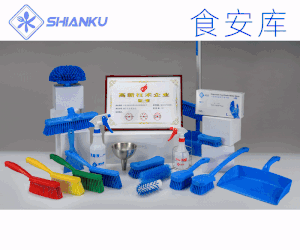食品伙伴網(wǎng)導(dǎo)讀:2010年7月9日華盛頓 - 農(nóng)業(yè)部長(zhǎng)維爾薩克和衛(wèi)生與人類服務(wù)凱瑟琳西貝柳斯女士今天贊揚(yáng)他們的食品安全工作小組支持奧巴馬總統(tǒng),負(fù)責(zé)就如何提升面向21世紀(jì)美國(guó)的總統(tǒng)負(fù)責(zé)的聯(lián)邦食品安全機(jī)構(gòu)食品安全體系的成績(jī)。食物安全工作小組,維爾薩克和西貝利厄斯主持,建議公眾健康為重點(diǎn)的方針,以食品安全的三個(gè)核心原則:預(yù)防優(yōu)先,加強(qiáng)巡查和執(zhí)法的基礎(chǔ),以及提高應(yīng)對(duì)和恢復(fù)。
原文報(bào)道:
Federal Agencies Announce Progress in First Year of Implementing Food Safety Working Group Recommendations
WASHINGTON, July 9, 2010 – Agriculture Secretary Tom Vilsack and Secretary of Health and Human Services Kathleen Sebelius today commended federal food safety agencies for their accomplishments supporting the charge of President Obama's Food Safety Working Group, which advises the President on how to upgrade the U.S. food safety system for the 21st century. The Food Safety Working Group, chaired by Vilsack and Sebelius, recommended a public health-focused approach to food safety based on three core principles: prioritizing prevention; strengthening inspection and enforcement; and improving response and recovery.
"I'm proud of the significant progress that has been made to protect public health since the Food Safety Working Group announced its key findings last July," said Secretary Vilsack. "There is no more basic role for government than ensuring safe food and completing the Food Safety Working Group's executive actions is an important step in strengthening the U.S. food safety system."
"HHS and USDA are focusing on public health as we work to improve the safety of our food supply, said Secretary Sebelius. "Our farm-to-table prevention approach acknowledges the complexity and diversity of all the people and organizations involved in food production."
The following are a few of the highlights of the progress and accomplishments USDA and HHS have achieved during the year:
Prioritizing Prevention
Salmonella in poultry and eggs: USDA issued revised draft standards for the presence of Salmonella to reduce consumers' exposure to this pathogen in raw poultry products. HHS issued a rule to control Salmonella contamination of eggs during production, storage, and transportation, and by July 9, 2010, approximately 82 percent of shell eggs will be covered under the new requirements.
Produce safety: On July 31, 2009, HHS issued commodity-specific draft guidance documents to industry on agricultural practices to reduce the risk of microbial contamination in the production and distribution of tomatoes, melons and leafy greens and is developing a proposed produce safety rule.
E. coli O157:H7 in beef products: USDA began a new verification testing program for beef bench trim and issued draft guidelines on methods for controlling E. coli O157:H7 on the farm, before cattle come to slaughter.
Laboratory diagnosis of E. coli: In October 2009, HHS published new guidance for clinical laboratories to improve diagnosis and surveillance for Shiga toxin-producing E. coli infections.
Campylobacter: USDA proposed the first ever standards for Campylobacter in poultry.
Measuring progress on food safety: Knowing what food safety interventions are working helps in designing future preventive efforts. HHS and USDA are collaborating to address the methodological and data challenges involved in the development of feasible and effective food safety metrics, with a joint meeting scheduled for July 21 in Chicago.
Strengthening Inspection and Enforcement
Reportable Food Registry: HHS launched the Reportable Food Registry (RFR), an electronic portal for industry and public health officials to report when there is reasonable probability that a food item will cause serious adverse health consequences.
Environmental assessments: USDA and HHS are developing a training program for environmental health specialists on how to properly conduct an environmental assessment during a foodborne outbreak investigation, leading to quicker and more definitive results.
Data analysis: USDA is preparing to launch a dramatically improved surveillance and data collection and analysis system in the fall. The Public Health Information System (PHIS) will help USDA/FSIS respond more rapidly to current and potential threats in the food safety system, which is crucial to preventing contamination, recalls and, ultimately, foodborne illnesses.
Improving Response and Recovery
Improving disease surveillance: HHS launched a new web-based surveillance platform to enhance the speed and completeness of foodborne outbreak reports, and developed an online database to make the data more easily accessible by the public. HHS and USDA published the first joint executive report on antimicrobial resistance among pathogens from food animals, retail meats and human clinical cases based on this data up to 2007; this was the first time all the data was available in one report.
Product tracing systems: HHS and USDA held a public meeting on steps the food industry can take to establish product tracing systems and are seeking public comment. HHS/FDA completed a pilot study on tracing with the tomato industry and is planning several other pilot studies to assess the feasibility of different tracing systems and technology/commodity combinations.
Collaborative investigation or identification of outbreaks: Since July 2009, HHS has coordinated or led more than 15 major multistate outbreak food-related investigations. These investigations have identified new food vehicles, including peppered Italian-style deli meat, and a new foodborne pathogen (Shiga-toxin producing E. coli O145), and have led to major product recalls. All involved close collaboration among federal agencies.
New efforts to strengthen investigation and response: USDA and HHS have begun piloting the use of dedicated local or state interview teams to increase the completeness of routine case interviews and have announced funding of expanded programs in sentinel sites for FY2010, leading to best practices for rapid outbreak investigation and response in a variety of local settings. In July 2009, the Council to Improve Foodborne Outbreak Response (CIFOR) published the Guidelines for Foodborne Outbreak Disease Response, which was endorsed by the Secretaries of HHS and USDA, and distributed to all county and state health and food safety agencies.
Supporting State and Local Health Agencies: HHS supported eight domestic training courses on epidemiological and laboratory methods related to food safety, and trained 20 state public health laboratories in the new molecular Salmonella serotyping method, which will make laboratory surveillance to detect outbreaks faster and more complete.
Rapid response to contamination incidents: Federal agencies are responding more aggressively to reports of contamination in an effort to remove potentially contaminated product from the market before it can cause illness. HHS and USDA formed an "Improving Foodborne Outbreak Investigations" working group to determine and implement best practices, including training, early detection, communications and response. In addition, USDA/FSIS and HHS/FDA have established Chief Medical Officer (CMO) positions, with each CMO leading and overseeing all phases of foodborne outbreak investigations including planning, training, early detection, improved communication, response and incorporating lessons learned into prevention based efforts within our programs.
New consumer communication technologies: HHS and USDA rolled out an enhanced and updated www.foodsafety.gov site in September 2009. As part of that release, a new food safety widget was created to provide customers rapid access to information on food recalls. HHS and USDA also collaborated on a new mobile application for smartphones that provides consumers with easy access to recent food recalls and alerts.
Incident Command System: Federal agencies implemented a new incident command system that links all relevant agencies to address outbreaks of foodborne illness. This approach facilitates communication and decision-making in an emergency, including with state and local governments.
原文報(bào)道:
Federal Agencies Announce Progress in First Year of Implementing Food Safety Working Group Recommendations
WASHINGTON, July 9, 2010 – Agriculture Secretary Tom Vilsack and Secretary of Health and Human Services Kathleen Sebelius today commended federal food safety agencies for their accomplishments supporting the charge of President Obama's Food Safety Working Group, which advises the President on how to upgrade the U.S. food safety system for the 21st century. The Food Safety Working Group, chaired by Vilsack and Sebelius, recommended a public health-focused approach to food safety based on three core principles: prioritizing prevention; strengthening inspection and enforcement; and improving response and recovery.
"I'm proud of the significant progress that has been made to protect public health since the Food Safety Working Group announced its key findings last July," said Secretary Vilsack. "There is no more basic role for government than ensuring safe food and completing the Food Safety Working Group's executive actions is an important step in strengthening the U.S. food safety system."
"HHS and USDA are focusing on public health as we work to improve the safety of our food supply, said Secretary Sebelius. "Our farm-to-table prevention approach acknowledges the complexity and diversity of all the people and organizations involved in food production."
The following are a few of the highlights of the progress and accomplishments USDA and HHS have achieved during the year:
Prioritizing Prevention
Salmonella in poultry and eggs: USDA issued revised draft standards for the presence of Salmonella to reduce consumers' exposure to this pathogen in raw poultry products. HHS issued a rule to control Salmonella contamination of eggs during production, storage, and transportation, and by July 9, 2010, approximately 82 percent of shell eggs will be covered under the new requirements.
Produce safety: On July 31, 2009, HHS issued commodity-specific draft guidance documents to industry on agricultural practices to reduce the risk of microbial contamination in the production and distribution of tomatoes, melons and leafy greens and is developing a proposed produce safety rule.
E. coli O157:H7 in beef products: USDA began a new verification testing program for beef bench trim and issued draft guidelines on methods for controlling E. coli O157:H7 on the farm, before cattle come to slaughter.
Laboratory diagnosis of E. coli: In October 2009, HHS published new guidance for clinical laboratories to improve diagnosis and surveillance for Shiga toxin-producing E. coli infections.
Campylobacter: USDA proposed the first ever standards for Campylobacter in poultry.
Measuring progress on food safety: Knowing what food safety interventions are working helps in designing future preventive efforts. HHS and USDA are collaborating to address the methodological and data challenges involved in the development of feasible and effective food safety metrics, with a joint meeting scheduled for July 21 in Chicago.
Strengthening Inspection and Enforcement
Reportable Food Registry: HHS launched the Reportable Food Registry (RFR), an electronic portal for industry and public health officials to report when there is reasonable probability that a food item will cause serious adverse health consequences.
Environmental assessments: USDA and HHS are developing a training program for environmental health specialists on how to properly conduct an environmental assessment during a foodborne outbreak investigation, leading to quicker and more definitive results.
Data analysis: USDA is preparing to launch a dramatically improved surveillance and data collection and analysis system in the fall. The Public Health Information System (PHIS) will help USDA/FSIS respond more rapidly to current and potential threats in the food safety system, which is crucial to preventing contamination, recalls and, ultimately, foodborne illnesses.
Improving Response and Recovery
Improving disease surveillance: HHS launched a new web-based surveillance platform to enhance the speed and completeness of foodborne outbreak reports, and developed an online database to make the data more easily accessible by the public. HHS and USDA published the first joint executive report on antimicrobial resistance among pathogens from food animals, retail meats and human clinical cases based on this data up to 2007; this was the first time all the data was available in one report.
Product tracing systems: HHS and USDA held a public meeting on steps the food industry can take to establish product tracing systems and are seeking public comment. HHS/FDA completed a pilot study on tracing with the tomato industry and is planning several other pilot studies to assess the feasibility of different tracing systems and technology/commodity combinations.
Collaborative investigation or identification of outbreaks: Since July 2009, HHS has coordinated or led more than 15 major multistate outbreak food-related investigations. These investigations have identified new food vehicles, including peppered Italian-style deli meat, and a new foodborne pathogen (Shiga-toxin producing E. coli O145), and have led to major product recalls. All involved close collaboration among federal agencies.
New efforts to strengthen investigation and response: USDA and HHS have begun piloting the use of dedicated local or state interview teams to increase the completeness of routine case interviews and have announced funding of expanded programs in sentinel sites for FY2010, leading to best practices for rapid outbreak investigation and response in a variety of local settings. In July 2009, the Council to Improve Foodborne Outbreak Response (CIFOR) published the Guidelines for Foodborne Outbreak Disease Response, which was endorsed by the Secretaries of HHS and USDA, and distributed to all county and state health and food safety agencies.
Supporting State and Local Health Agencies: HHS supported eight domestic training courses on epidemiological and laboratory methods related to food safety, and trained 20 state public health laboratories in the new molecular Salmonella serotyping method, which will make laboratory surveillance to detect outbreaks faster and more complete.
Rapid response to contamination incidents: Federal agencies are responding more aggressively to reports of contamination in an effort to remove potentially contaminated product from the market before it can cause illness. HHS and USDA formed an "Improving Foodborne Outbreak Investigations" working group to determine and implement best practices, including training, early detection, communications and response. In addition, USDA/FSIS and HHS/FDA have established Chief Medical Officer (CMO) positions, with each CMO leading and overseeing all phases of foodborne outbreak investigations including planning, training, early detection, improved communication, response and incorporating lessons learned into prevention based efforts within our programs.
New consumer communication technologies: HHS and USDA rolled out an enhanced and updated www.foodsafety.gov site in September 2009. As part of that release, a new food safety widget was created to provide customers rapid access to information on food recalls. HHS and USDA also collaborated on a new mobile application for smartphones that provides consumers with easy access to recent food recalls and alerts.
Incident Command System: Federal agencies implemented a new incident command system that links all relevant agencies to address outbreaks of foodborne illness. This approach facilitates communication and decision-making in an emergency, including with state and local governments.











 地區(qū):
地區(qū):






 魯公網(wǎng)安備 37060202000128號(hào)
魯公網(wǎng)安備 37060202000128號(hào)



